learn how
Traditional Weaver - Nilda Callañaupa Alvarez - The Communities
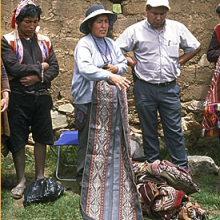
Come with us on a tour of four communities: Pitumarca, Chahuaytiri (left), Chinchero and Aacha Alta. In each community, weavers are reviving their ancient traditions with the help of Nilda and her Center. These communities are within a couple of hours driving distance from Cusco, in the southern highlands of Peru. In each place, Quechua-speaking women and men meet weekly. In a shelter built by the CTTC, they spin, weave and knit. Nilda visits regularly (often with her husband Paulino) to buy textiles for the Center, to give encouragement, and to experiment with dyeing processes.
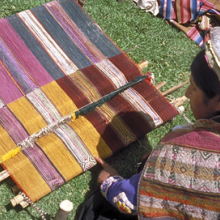
In Pitumarca, weavers practice the ancient technique of discontinuous warp (called t'iqulla in Quechua), a skill once thought to have disappeared. In most textiles, the warp yarn is continuous throughout the length of the cloth. However, in some ancient Peruvian textiles, the warp is discontinuous for the sake of patterning. This means the warp yarns turn back at the point of colour change. This is a laborious method, as scaffolding yarns must be set up, and weaving is slow as separate shedding devices have to be used in each colour area.
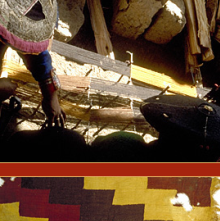
The Textile Museum of Canada has in its collection (T94.1013) a Pre-Columbian discontinuous warp and weft weaving dated A.D. 1300-1550. Nilda brought an image of this piece to the weavers in Pitumarca, and they worked out a method to duplicate it. The warp was prepared by weavers Elizabeth Navarro, Felicitas Mamani, Florencia Ccoma and Mauya Ayayu. They have calculated the spacing of the colour patterns and are wrapping warp yarns around steel rods staked in the ground. Check back with CLOTH & CLAY at a later date to see their finished replica of this ancient highland textile.
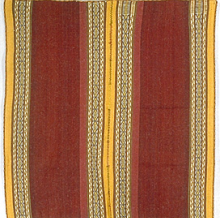
Our next stop is the community of Chinchero, which is located in a lush valley and has a bustling Sunday market. Warp-faced weaving is a technique widely used in this area. In this method, patterns in the cloth are made by the warp threads, which completely cover the weft threads. There are two main types of warp-faced cloth that are being made in the Peruvian Andes today: Complementary warp and Supplementary warp.
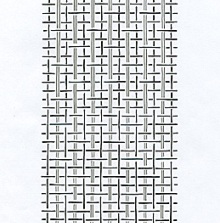
Warps of two different colours are set up in two complementary sets that are integral to the structure of the fabric. Unlike supplementary weft, there is no ground cloth on top of which the pattern is created. Each warp has its counterpart on the opposite face of the cloth, and the design is achieved from the two sets of warps interlacing with the weft. The result is a design with the colours in reverse on each face.
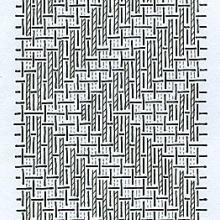
The supplementary warp technique is a way of introducing warp patterning into a woven fabric, by floating extra warps over the plain weave ground, without disturbing the basic structure of the weave. The supplementary warps are interlaced regularly with the weft between the ground warps as inserts, and floated on the back in other areas.
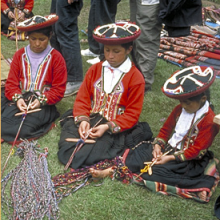
In Chinchero, young girls belong to the Jakima Club, which was established by Nilda to encourage partnerships between children learning to weave and experienced weavers. Jakima is the Quechua name for the narrow patterned ribbons that in the past, all Quechua children learned how to make. Competitions are held and awards are given to the most talented weavers.
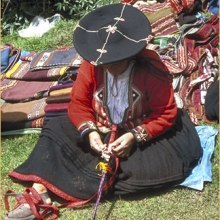
In Chinchero, experienced weavers weave elaborate, weft-patterned skirt borders or golons, using several heddles. This may have begun as an imitation of an early Spanish fabric, but today these borders are woven in beautiful designs with complex techniques.
Here a woman from Chinchero is weaving a skirt border like the one she has on her own garment.
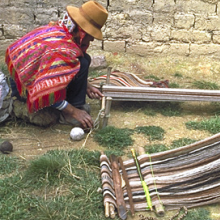
Aacha Alta is a community located higher in the mountains where llamas and alpacas graze. Through Nilda's encouragement over the last four years, they have abandoned the use of commercially spun acrylic yarn. They herd alpaca and sheep, and farm potatoes. They have also begun to weave their traditional potato sacks again (see left), called costales, which had been replaced in recent years by plastic sacks. These are made with alpaca and llama wool in natural colours, as are their braided slings and ropes.
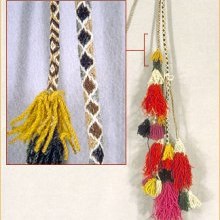
Another tradition of Aacha Alta is braiding. In the past, complex and varied braids were produced - some with up to 24 strands, several colours and intricate patterning. Today, men continue to braid slings and rope. Slings were used in pre-Spanish times by the Inka military, by farmers to protect their crops from birds and animals, and by herders to guide llamas and alpacas. Ornamental braided slings, such as the example pictured left made elsewhere in the Cusco area, continue to be used in ceremony. Sometimes worn at the waist or swung high in the air, these slings often have attached tassels, pompoms and fringes.
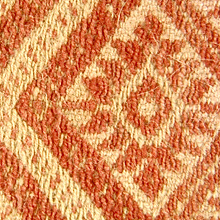
In Aacha Alta another type of warp-faced patterning is used, where the yarns of the design are not a part of the ground cloth. Rather, one of the colours of the warp is supplementary. This is called ley pallay, or supplementary warp, and it results in a one-faced textile. In this example, the red supplementary floats are on a paired warp ground.
A unique quality of Aacha Alta is their spinning. Unlike other villages, where only women spin yarn, both men and women spin in Aacha Alta.
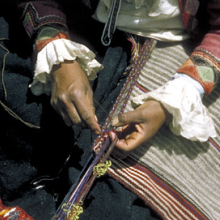
Chahuaytiri is a community in the hills above the Sacred Valley of the Inkas. Here, the weavers use both backstrap and four-stake looms, and both the men and women weave. In this image, a weaver is making a beautiful edging for the bags and mantles. It is a tubular finishing technique, which is used around the borders of mantles and called ñawi awapa ("eye of the cloth").
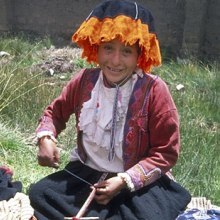
In addition to weaving, all married women in the village spin and otherwise prepare the yarn used by their husbands. The men weave most of the larger pieces of cloth. Women often weave smaller (but equally complex) finishing elements, such as the ribbons (watana) seen here which decorate the hats knitted and worn by men. Watana incorporate beads within the weft at regular intervals. This is accomplished by stringing the weft yarns through all of the beads, set at the desired intervals, before weaving them into the cloth.
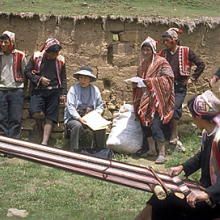
Nilda, seen here meeting with the weavers from Chahuaytiri, realizes that it may take several years to bring the weaving back to the quality of earlier times. She takes heart and is inspired to continue her work each time an elderly weaver passes knowledge on to a younger weaver, allowing an important part of Inka culture to live on.

In addition to being excellent weavers, the men in Chahuaytiri knit. They use five needles in the round: four to hold the work, and one to transfer stitches. The work is very fine - some as fine as eight rows per centimetre - and they work with very thin needles made from bicycle spokes. The yarn is tightly spun and plied. In some areas (such as Chinchero), the needles are pointed at both ends, while in other Cusco areas, one end of each needle is hooked. Almost all the work is purling.
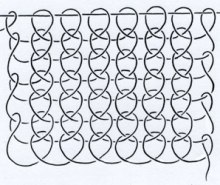
Knitting was not known in the Americas prior to the European conquest, and was introduced during the Colonial Period. There are ancient examples of looped hats; however, they were made with the technique of cross-knit looping, an ancient and more laborious method than true knitting. Today, men's knitted caps (ch'ullu) are commonly worn in many highland communities in Peru and Bolivia.
Image: Line drawing of the cross knit loop stitch by Kristiina Lahde.

The cross-knit loop stitch first appeared in the early Nasca period (ca. B.C. 400). It is somewhat related to needle lace, also done with looping, but Nasca style embroidery uses a single type of looping. In this Peruvian stitch, a loop is formed that is closed by the crossing of the yarn, which passes back over itself. It is done with a single needle and the completed network resembles knitting, although there is this structural difference. Using this relatively simple technique, the ancient Peruvians created elaborate designs on a very fine scale. There is no evidence that the ancient Peruvians ever did true knitting with a hook or knitting needles.